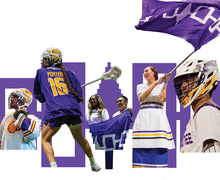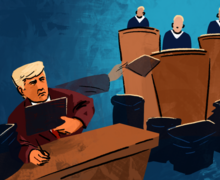Back to the future: After contentious semester, Student Association leaders return to campus for fresh start
/ Sam Maller | Asst. Photo Editor
Allie Curtis, president of Student Association, is positive about the upcoming semester despite nearly facing impeachment last spring.
It’s a fresh start for Student Association.
President Allie Curtis and Vice President Duane Ford say they’re going to accomplish set initiatives to help the student body. Now that Curtis is halfway through her tenure as president, she and the organization plan to move on from the events of last semester, which saw a six-hour executive session to vote for charging Curtis with impeachment. And despite eight of the 11 cabinet members leaving earlier than expected, they say the organization will move forward with energized new members.
“I have a very positive outlook on this semester,” Curtis said.
Specifically, Curtis said she’s looking forward to carrying on with Impact Week, addressing student tuition and focusing on retention within SA.
She also said she intends to use feedback from last semester to improve her leadership style. For example, she now copies Vice President Duane Ford to all cabinet application emails.
“I’m not just the sole communicator amongst all of us,” she said.
She’s also learned to be thorough, she said, adding that business gets done by putting things on a calendar. “You have to take things a step at a time,” Curtis said. “I think people frequently get too far ahead of themselves.”
Ford is also working on projects.
He mostly devoted his summer to working with the Office of Government and Community Relations in an effort to outfit Euclid Avenue with trash cans. Someone from the university approached Ford with the idea. Ford signed on because he saw the need for SA to help off-campus students and clean up the surrounding area.
He also referenced criticism from the student body in the spring that the organization had not lived up to expectations of working for students. He said SA did manage to better the campus community. The organization constantly works behind the scenes to better university life, but Ford said the trash cans will serve as a reminder of that presence.
“That’s a physical, very tangible change on campus, that you will see,” Ford said, stressing that conversations are ongoing and he is still working with the university to establish SA’s role in the process.
As of now, Ford said, they’re planning on launching 12 trash cans at first and assessing how they withstand Syracuse’s winter and other wear-and-tears.
Last semester, the Student Engagement Committee also managed to set up a comment box in the Schine Student Center and introduce a new smartphone and website application that can garner student feedback. Ford also said that issues last semester “gave us [SA] more drive” and caused those within the organization to grow closer.
Regarding the high turnover of cabinet members, Ford said incoming officers will naturally face a learning curve but described the situation as “a little bit of a blessing in disguise.” The vacancies will allow others heavily involved in the organization to step into larger roles.
Comptroller Stephen DeSalvo appeared to share this view, saying the semester will be interesting with SA losing a significant portion of its officers.
He also said this isn’t necessarily a huge problem, since newer members will be able to move up. He said the dynamic will be interesting.
DeSalvo also spoke positively of Curtis, saying he thinks she will lead “like we’ve never seen her lead before.”
Jonathan Taylor, one of the founders and co-chair of the Student Association & Student Government Association Alumni Organization, said he would argue, “with the beginning of the new semester, even though it’s the same session, in the eyes of the president you have a clean start.”
The organization’s purpose is to document the history of SA going forward, and to try to maintain institutional memory to benefit current officers in the association. The SA/SGA Alumni Organization also documents the main accomplishments of each semester and tracks changes to the SA constitution.
He said since the SA constitution was rewritten in 1998, establishing the modern office of the president, the position has remained stable — unlike the speaker position. This has allowed for “continuity of leadership.”
Taylor was a School of Architecture representative in the student assembly for six legislative sessions and held other positions such as parliamentarian and speaker of the assembly, the equivalent of president today.
After the 39th Session — the first he served in — only three members of the assembly and about a dozen officers came back, he said. The assembly was mostly made up of freshmen, with more than 60 voting representatives, he said, but it was also very effective.
Taylor said he made it a goal to make sure retention was better, and next session most returned.
By changing the timing of the session to the calendar year, this has also helped the president, Taylor said, because cabinet and assembly also have existed during the summer.
He said the challenge for any president is to moderate discussion in the student assembly. Members of the assembly have items they want to accomplish, and the president does as well.
“They have to come up with a way to work together,” he said, stressing that he was speaking in general terms and not specifically about the current session.
Published on August 26, 2013 at 1:40 am
Contact Dylan: dmsegelb@syr.edu | @dylan_segelbaum





